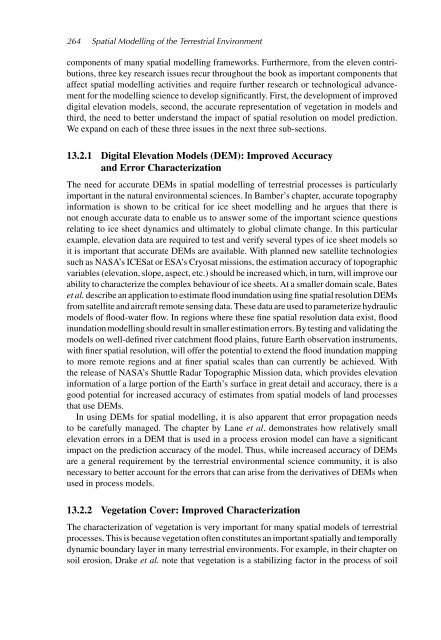1 Spatial Modelling of the Terrestrial Environment - Georeferencial
1 Spatial Modelling of the Terrestrial Environment - Georeferencial
1 Spatial Modelling of the Terrestrial Environment - Georeferencial
You also want an ePaper? Increase the reach of your titles
YUMPU automatically turns print PDFs into web optimized ePapers that Google loves.
264 <strong>Spatial</strong> <strong>Modelling</strong> <strong>of</strong> <strong>the</strong> <strong>Terrestrial</strong> <strong>Environment</strong><br />
components <strong>of</strong> many spatial modelling frameworks. Fur<strong>the</strong>rmore, from <strong>the</strong> eleven contributions,<br />
three key research issues recur throughout <strong>the</strong> book as important components that<br />
affect spatial modelling activities and require fur<strong>the</strong>r research or technological advancement<br />
for <strong>the</strong> modelling science to develop significantly. First, <strong>the</strong> development <strong>of</strong> improved<br />
digital elevation models, second, <strong>the</strong> accurate representation <strong>of</strong> vegetation in models and<br />
third, <strong>the</strong> need to better understand <strong>the</strong> impact <strong>of</strong> spatial resolution on model prediction.<br />
We expand on each <strong>of</strong> <strong>the</strong>se three issues in <strong>the</strong> next three sub-sections.<br />
13.2.1 Digital Elevation Models (DEM): Improved Accuracy<br />
and Error Characterization<br />
The need for accurate DEMs in spatial modelling <strong>of</strong> terrestrial processes is particularly<br />
important in <strong>the</strong> natural environmental sciences. In Bamber’s chapter, accurate topography<br />
information is shown to be critical for ice sheet modelling and he argues that <strong>the</strong>re is<br />
not enough accurate data to enable us to answer some <strong>of</strong> <strong>the</strong> important science questions<br />
relating to ice sheet dynamics and ultimately to global climate change. In this particular<br />
example, elevation data are required to test and verify several types <strong>of</strong> ice sheet models so<br />
it is important that accurate DEMs are available. With planned new satellite technologies<br />
such as NASA’s ICESat or ESA’s Cryosat missions, <strong>the</strong> estimation accuracy <strong>of</strong> topographic<br />
variables (elevation, slope, aspect, etc.) should be increased which, in turn, will improve our<br />
ability to characterize <strong>the</strong> complex behaviour <strong>of</strong> ice sheets. At a smaller domain scale, Bates<br />
et al. describe an application to estimate flood inundation using fine spatial resolution DEMs<br />
from satellite and aircraft remote sensing data. These data are used to parameterize hydraulic<br />
models <strong>of</strong> flood-water flow. In regions where <strong>the</strong>se fine spatial resolution data exist, flood<br />
inundation modelling should result in smaller estimation errors. By testing and validating <strong>the</strong><br />
models on well-defined river catchment flood plains, future Earth observation instruments,<br />
with finer spatial resolution, will <strong>of</strong>fer <strong>the</strong> potential to extend <strong>the</strong> flood inundation mapping<br />
to more remote regions and at finer spatial scales than can currently be achieved. With<br />
<strong>the</strong> release <strong>of</strong> NASA’s Shuttle Radar Topographic Mission data, which provides elevation<br />
information <strong>of</strong> a large portion <strong>of</strong> <strong>the</strong> Earth’s surface in great detail and accuracy, <strong>the</strong>re is a<br />
good potential for increased accuracy <strong>of</strong> estimates from spatial models <strong>of</strong> land processes<br />
that use DEMs.<br />
In using DEMs for spatial modelling, it is also apparent that error propagation needs<br />
to be carefully managed. The chapter by Lane et al. demonstrates how relatively small<br />
elevation errors in a DEM that is used in a process erosion model can have a significant<br />
impact on <strong>the</strong> prediction accuracy <strong>of</strong> <strong>the</strong> model. Thus, while increased accuracy <strong>of</strong> DEMs<br />
are a general requirement by <strong>the</strong> terrestrial environmental science community, it is also<br />
necessary to better account for <strong>the</strong> errors that can arise from <strong>the</strong> derivatives <strong>of</strong> DEMs when<br />
used in process models.<br />
13.2.2 Vegetation Cover: Improved Characterization<br />
The characterization <strong>of</strong> vegetation is very important for many spatial models <strong>of</strong> terrestrial<br />
processes. This is because vegetation <strong>of</strong>ten constitutes an important spatially and temporally<br />
dynamic boundary layer in many terrestrial environments. For example, in <strong>the</strong>ir chapter on<br />
soil erosion, Drake et al. note that vegetation is a stabilizing factor in <strong>the</strong> process <strong>of</strong> soil

















